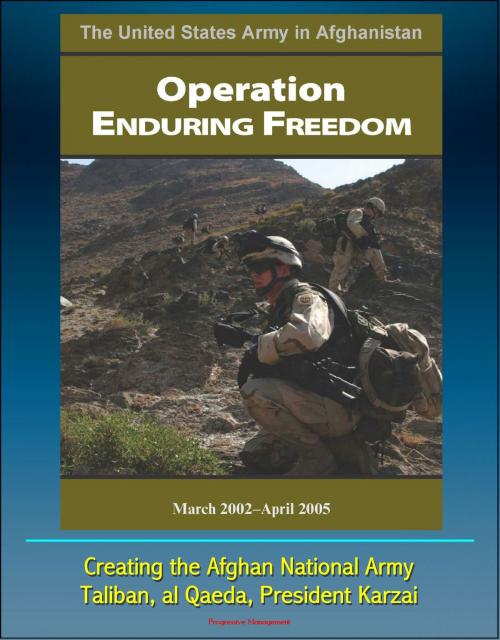The United States Army in Afghanistan: Operation Enduring Freedom, March 2002 - April 2005 - Creating the Afghan National Army, Taliban, al Qaeda, President Karzai
Nonfiction, History, Military| Author: | Progressive Management | ISBN: | 9781301198849 |
| Publisher: | Progressive Management | Publication: | August 2, 2013 |
| Imprint: | Smashwords Edition | Language: | English |
| Author: | Progressive Management |
| ISBN: | 9781301198849 |
| Publisher: | Progressive Management |
| Publication: | August 2, 2013 |
| Imprint: | Smashwords Edition |
| Language: | English |
The terrorist attacks on the World Trade Center and the Pentagon on 11 September 2001 dramatically changed the world in which we live. Never had an enemy attacked us on our own soil to such effect. Over three thousand Americans and several hundred foreign nationals from over ninety countries died that day at the hands of a ruthless, and to some degree faceless, enemy. The terrorist organization known as al-Qaeda, perpetrator of the attack, operated in the shadows to take advantage of the freedom and openness that are American hallmarks. Afghanistan, a known training ground and a safe haven for al-Qaeda, quickly became the focus of the first military efforts to strike back. Osama bin Laden, al-Qaeda's enigmatic leader, believed he and his followers were beyond the reach of American arms in that far-off mountainous land, protected by its fanatical Taliban regime. Bin Laden was wrong, and America reached deep into Central Asia to find his organization and neutralize it. Most Americans are familiar with the military operation that subsequently took place in Afghanistan. In a matter of months, the U.S. Army, Air Force, Marine Corps, and Navy, in a masterful display of joint operations and in concert with our Afghan allies, overthrew the Taliban regime and drove the terrorist al-Qaeda into worldwide flight.
This document provides details on the role of the U.S. Army in the critical three-year period following the conclusion of Operation Anaconda in March 2002. It details the story of American and international forces working to solidify the initial invasion's crippling of al-Qaeda and removal of the Taliban. It recounts the story of the quest to build a new, democratic Afghan government capable of maintaining internal security and tending to the needs of the Afghan people. It tells the tale of the U.S. Army's search for a proper balance between counterterrorism and counterinsurgency operations as the enemy rebuilt his forces from safe havens in Pakistan. Finally, it chronicles the Army's efforts to maintain an effective presence in Afghanistan while juggling the challenges of an indigenous population historically opposed to foreign forces and the decreased resources available after the start of the Iraq war in 2003.
Operation Enduring Freedom, March 2002 - April 2005 was written by historians Dr. Brian F. Neumann, Dr. Lisa Mundey, and Dr. Jon Mikolashek in the Histories Division of the Center of Military History. We hope that you enjoy and profit from this dramatic but often overlooked story of our Army in action in the Global War on Terrorism.
Strategic Setting * Operations * Operation Mountain Lion * Combined Joint Task Force-82 Arrives * Creating the Afghan National Army * Civil-Military Operations * Reorganizing CJTF-180 * Combined Forces Command-Afghanistan Takes Over * Shift in Mission Focus * Reorganizing Under Combined Joint Task Force-76 * Searching for Stability * The Calm Before the Storm * Analysis * Further Readings * Abbreviations
The terrorist attacks on the World Trade Center and the Pentagon on 11 September 2001 dramatically changed the world in which we live. Never had an enemy attacked us on our own soil to such effect. Over three thousand Americans and several hundred foreign nationals from over ninety countries died that day at the hands of a ruthless, and to some degree faceless, enemy. The terrorist organization known as al-Qaeda, perpetrator of the attack, operated in the shadows to take advantage of the freedom and openness that are American hallmarks. Afghanistan, a known training ground and a safe haven for al-Qaeda, quickly became the focus of the first military efforts to strike back. Osama bin Laden, al-Qaeda's enigmatic leader, believed he and his followers were beyond the reach of American arms in that far-off mountainous land, protected by its fanatical Taliban regime. Bin Laden was wrong, and America reached deep into Central Asia to find his organization and neutralize it. Most Americans are familiar with the military operation that subsequently took place in Afghanistan. In a matter of months, the U.S. Army, Air Force, Marine Corps, and Navy, in a masterful display of joint operations and in concert with our Afghan allies, overthrew the Taliban regime and drove the terrorist al-Qaeda into worldwide flight.
This document provides details on the role of the U.S. Army in the critical three-year period following the conclusion of Operation Anaconda in March 2002. It details the story of American and international forces working to solidify the initial invasion's crippling of al-Qaeda and removal of the Taliban. It recounts the story of the quest to build a new, democratic Afghan government capable of maintaining internal security and tending to the needs of the Afghan people. It tells the tale of the U.S. Army's search for a proper balance between counterterrorism and counterinsurgency operations as the enemy rebuilt his forces from safe havens in Pakistan. Finally, it chronicles the Army's efforts to maintain an effective presence in Afghanistan while juggling the challenges of an indigenous population historically opposed to foreign forces and the decreased resources available after the start of the Iraq war in 2003.
Operation Enduring Freedom, March 2002 - April 2005 was written by historians Dr. Brian F. Neumann, Dr. Lisa Mundey, and Dr. Jon Mikolashek in the Histories Division of the Center of Military History. We hope that you enjoy and profit from this dramatic but often overlooked story of our Army in action in the Global War on Terrorism.
Strategic Setting * Operations * Operation Mountain Lion * Combined Joint Task Force-82 Arrives * Creating the Afghan National Army * Civil-Military Operations * Reorganizing CJTF-180 * Combined Forces Command-Afghanistan Takes Over * Shift in Mission Focus * Reorganizing Under Combined Joint Task Force-76 * Searching for Stability * The Calm Before the Storm * Analysis * Further Readings * Abbreviations















